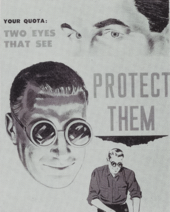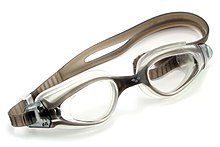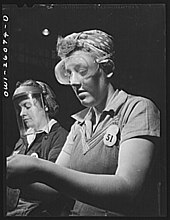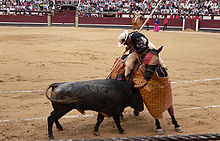
Personal protective equipment (PPE) is protective clothing, helmets, goggles, or other garments or equipment designed to protect the wearer's body from injury or infection. The hazards addressed by protective equipment include physical, electrical, heat, chemical, biohazards, and airborne particulate matter. Protective equipment may be worn for job-related occupational safety and health purposes, as well as for sports and other recreational activities. Protective clothing is applied to traditional categories of clothing, and protective gear applies to items such as pads, guards, shields, or masks, and others. PPE suits can be similar in appearance to a cleanroom suit.

Glasses, also known as eyeglasses or spectacles, are vision eyewear with clear or tinted lenses mounted in a frame that holds them in front of a person's eyes, typically utilizing a bridge over the nose and hinged arms, known as temples or temple pieces, that rest over the ears.

To improve motorcycle safety, many countries mandate the wearing of personal protective equipment such as protective clothing and helmets. Protective clothing may include certain types of jackets, gloves, boots, and pants. Jackets meant for motorcyclists are typically made of leather or specialized man-made fabrics like cordura or Kevlar. These jackets typically include padding on the elbow, spine, and shoulder regions. This was once quite bulky, but modern technology and materials have made it unobtrusive. Gloves are generally made of leather or Kevlar and some include carbon fiber knuckle protection. Boots, especially those for sport riding, include reinforcement and plastic caps on the ankle and toe areas. Pants are usually leather, cordura, or Kevlar. Except for helmets, none of these items are required by law in any state in the USA, or in any part of the UK but are recommended by many of those who ride.

Sunglasses or sun glasses are a form of protective eyewear designed primarily to prevent bright sunlight and high-energy visible light from damaging or discomforting the eyes. They can sometimes also function as a visual aid, as variously termed spectacles or glasses exist, featuring lenses that are colored, polarized or darkened. In the early 20th century, they were also known as sun cheaters.
Photokeratitis or ultraviolet keratitis is a painful eye condition caused by exposure of insufficiently protected eyes to the ultraviolet (UV) rays from either natural or artificial sources. Photokeratitis is akin to a sunburn of the cornea and conjunctiva.

A diving mask is an item of diving equipment that allows underwater divers, including scuba divers, free-divers, and snorkelers, to see clearly underwater. Surface supplied divers usually use a full face mask or diving helmet, but in some systems the half mask may be used. When the human eye is in direct contact with water as opposed to air, its normal environment, light entering the eye is refracted by a different angle and the eye is unable to focus the light on the retina. By providing an air space in front of the eyes, the eye is able to focus nearly normally. The shape of the air space in the mask slightly affects the ability to focus. Corrective lenses can be fitted to the inside surface of the viewport or contact lenses may be worn inside the mask to allow normal vision for people with focusing defects.

Eye protection is protective gear for the eyes, and sometimes face, designed to reduce the risk of injury. Examples of risks requiring eye protection can include: impact from particles or debris, light or radiation, wind blast, heat, sea spray or impact from some type of ball or puck used in sports.

A hazmat suit is a piece of personal protective equipment that consists of an impermeable whole-body garment worn as protection against hazardous materials.

Mirrored sunglasses are sunglasses with a reflective optical coating on the outside of the lenses to make them appear like small mirrors. The lenses typically give the wearer's vision a brown or grey tint. The mirror coating decreases the amount of light passing through the tinted lens by a further 10–60%, making it especially useful for conditions of sand, water, snow, and higher altitudes. Mirrored sunglasses are one-way mirrors.

Safety practices generally recommend that chainsaw users wear protective clothing, also known as personal protective equipment or PPE, while operating chainsaws. There is general agreement worldwide on what clothing is suitable, but local jurisdictions have specific rules and recommendations.

Corneal abrasion is a scratch to the surface of the cornea of the eye. Symptoms include pain, redness, light sensitivity, and a feeling like a foreign body is in the eye. Most people recover completely within three days.

Aviator sunglasses are a style of sunglasses that was developed by a group of American firms. The original Bausch & Lomb design is now commercially marketed as Ray-Ban Aviators, although other manufacturers also produce aviator-style sunglasses.

A welding helmet is a type of personal protective equipment used in performing certain types of welding to protect the eyes, face, and neck from flash burn, sparks, infrared and ultraviolet light, and intense heat. The modern welding helmet used today was first introduced in 1937 by Willson Products.

Sportswear or activewear is athletic clothing, including footwear, worn for sports activity or physical exercise. Sport-specific clothing is worn for most sports and physical exercise, for practical, comfort or safety reasons.
Potassium nitrate is an oxidizer so storing it near fire hazards or reducing agents should be avoided to minimise risk in case of a fire.

An eyeshield is a piece of football equipment that is also referred to as a visor that was created in the 1980s. In the mid 1990s as an effort to prevent brain and head injuries, headgear became mandatory in the game of football. The eyeshield was created to protect the eyes of football players during games and practices. It is a curved piece of plastic that attaches to the front of a football helmet. Safety equipment such as the facemask, eyeshields, and other face shields have been adopted over time to prevent player injury. The eyeshield leaves the mouth exposed, but covers the eyes and nose. The piece of equipment is made from various materials and by many different brands. Only clear eyeshields are permitted for use in high school football games because eyes are needed to be seen while checking for a concussion. For college level players, the eyeshield may be tinted for players with eye problems.

Zoggs is a brand of swimming goggles, training aids, swimwear and other related products. The company launched in Sydney, Australia in 1992 and was the first brand to offer UV protection and split yoke straps as standard features on all goggles.
Ballistic eyewear is a form of glasses or goggles that protect from small projectiles and fragments. For the U.S. military, choices are listed on the Authorized Protective Eyewear List (APEL). Ballistic eyewear including examples that meet APEL requirements are commercially available for anyone who wishes to buy it. The history of protective eyewear goes back to 1880 and extends through to World War I and the present. There are three standards that are currently used to test the effectiveness of ballistic eyewear. These include a U.S. civilian standard, a U.S. military standard (MIL-PRF-31013), and a European standard.

Personal protective equipment serves an integral role in maintaining the safety of an athlete participating in a sport. The usage and development of protective gear in sports has evolved through time, and continues to advance over time. Many sports league or professional sports mandate the provision and usage of protective gear for athletes in the sport. Usage of protective gear is also mandated in college athletics and occasionally in amateur sports.
Shred Optics is a manufacturer of sunglasses, helmets, and goggles designed for skiing, mountain biking, snowboarding, and other forms of outdoor recreation. The company is based in Park City, Utah, and Venice, Italy.
























